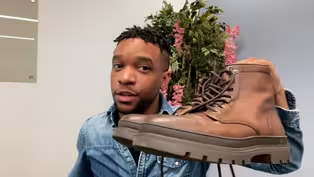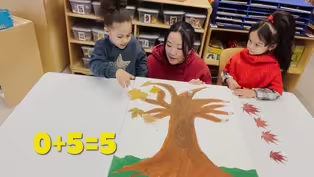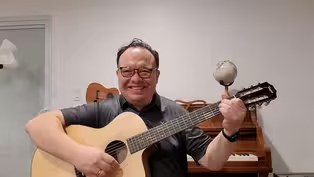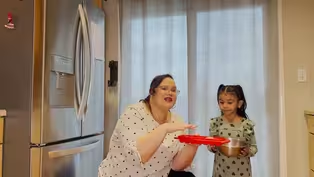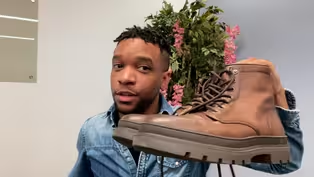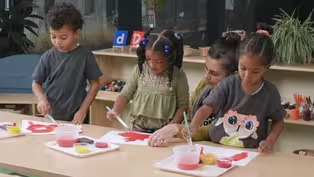
MAGIC E TURNS SHORT O INTO LONG O
Clip: 5/5/2023 | 11m 34sVideo has Audio Description, Closed Captions
Isabel Simmons transforms short o into long o with the magic letter e.
Isabel Simmons transforms the short o vowel sound into the long o vowel song by adding magic e to the end of the word.
See all videos with Audio DescriptionADProblems playing video? | Closed Captioning Feedback
Problems playing video? | Closed Captioning Feedback
Let's Learn is a local public television program presented by THIRTEEN PBS

MAGIC E TURNS SHORT O INTO LONG O
Clip: 5/5/2023 | 11m 34sVideo has Audio Description, Closed Captions
Isabel Simmons transforms the short o vowel sound into the long o vowel song by adding magic e to the end of the word.
See all videos with Audio DescriptionADProblems playing video? | Closed Captioning Feedback
How to Watch Let's Learn
Let's Learn is available to stream on pbs.org and the free PBS App, available on iPhone, Apple TV, Android TV, Android smartphones, Amazon Fire TV, Amazon Fire Tablet, Roku, Samsung Smart TV, and Vizio.
Providing Support for PBS.org
Learn Moreabout PBS online sponsorship[upbeat music] [whimsical ascending music] - Hello, friends.
Today I am transforming into a butterfly!
Do you know what else can transform?
Short and long vowels.
But they have to have help.
In order to change a short vowel like O that says, ah, into its long vowel of O that says, oh, it needs some help.
And the E is always around to give it a hand.
Are you ready to learn about how the magic of E helps the O transform into its long sound?
- [Kids] Yeah!
- Great, let's get started.
[whimsical descending music] Before we get ready to read about the magic of the E, we have to get our ears ready to tell the difference between the short O sound that says, ah and the long O sound that says, oh.
So, get your ears ready with me?
Good, what we're going to do today is we're going to play a game.
It's the stretching game.
So, if you hear the long sound of O, that says, oh, I want you to stretch up high.
And if you hear the short sound of O that says, ah, I want you to shrink as small as you can get.
Are you ready?
Okay, I'm gonna say a word.
You are gonna repeat the word.
We're going to listen for the vowel sound, oh or ah.
And then we're going to stretch or shrink.
The first word is "nope".
Can you say that word?
Nope.
Oh, I hear the, oh, did you?
Good job!
The next word is "pop".
That's right, we're going to shrink.
The next word is "tone".
Yep, good job!
The next word is "stop".
Ah.
All right, are you ready?
The last word is "stone".
Yes, excellent!
You're ready to learn about the magic E and how it changes the O.
Let's get started, yes!
Now we're ready to learn a little bit more about how this E, which I think is magic, will help vowels say their name, specifically help the O say it's long sound of oh.
Are you ready?
So if we have this word, in this word, the vowel sound O is going to be short.
It's going to say, ah.
Ha, ah, p. Hop, hop, right!
But when we add this E, the E will help the O say, it's long sound now of, oh.
But the E remains silent.
Shh, it doesn't make a sound.
So let's build this word together.
Ha, oh, p. Hope?
Hope!
The new word is hope.
I hope you like this lesson today!
Now let's try using this E in a new word.
I know that this is going to be a short sound because it's closed in by the consonant N, so, ka, ah, n. Con, con, it's when someone tries to trick you, right?
Well, what happens when we add the E?
What is our new word going to be now?
Remember, the E, which will be, will help the O say it's long sound of, oh.
ka, oh, n, cone.
Cone, like an ice cream cone!
I see.
Great, now that we've learned a little bit more about how the E can help the O say its name or long sound in words, it's time to read some words that use that skill.
Are you ready?
Here you're going to see three lines of text.
And before we read those lines, I want you to think about what you see.
So let's look at line number one.
What do you notice about these words?
That's great!
Do you know what I noticed?
I noticed that these two words are almost the same, and these two words are almost the same.
That's going to help me when it's time for me to read those words.
Did you see what I see?
You did?
Let's try to read these words together.
Cop, cope, good.
Mop, mope.
Now we're going to look at the second line of text.
What do you notice about these words?
I see these three letters are the same in these words and this word and this word are almost the same.
They only differ by one letter or one sound in this case, one letter, one sound.
Are you ready to read the words?
Let's go.
Woke, I woke up.
Joke, poke, pole, excellent.
Now let's look at the third line of text.
What do you notice that's the same in all four words?
That's right, I see an O, T, E. Those sounds together, remember, the E is silent.
Ote, ote, ote.
That's going to help me, are you ready to read?
Let's go, note, vote, tote, buddy letters, quote, good job!
When I quote someone, I repeat someone verbatim.
That means word for word.
Now that we've practiced reading, it is time for us to read a sentence together.
When I am sad, I mope.
That's an example of moping, that's my example.
Are you ready to go to the next activity?
Here's our last activity of the day.
We are going to write a word together.
So go ahead and get a paper or something to write on and a pencil or something to write with and come on back.
[upbeat music] Now we're going to write a word together.
Are you ready?
- [Kids] Yeah!
- Great, the word we're going to write is "home".
Can you repeat that word?
Great job!
Now let's tap that word out together.
Ha, oh, mm.
Great, now go ahead and write that word right now.
What nice handwriting you have.
Ah, beautiful!
Is this what you wrote?
Ha, oh, mm.
And what helps the O say its name at the end of words?
E, excellent, great job!
Today we have listened for the long O sound and the short O sound, and we've read words and written a word with that magic E that helps the O say oh.
Today, I'd like you to practice playing the stretching and shrinking game with your family members.
Have a wonderful day.
Bye, friends!
Video has Audio Description, Closed Captions
Clip: 6/12/2023 | 7m 54s | Carlton Ellen reads CITY FEET, written and illustrated by Aixa Perez-Prado. (7m 54s)
Video has Audio Description, Closed Captions
Clip: 5/5/2023 | 7m 35s | Zoe Kleinmann plays a math game to transform a tree by adding leaves to its branches. (7m 35s)
Video has Audio Description, Closed Captions
Clip: 5/5/2023 | 7m 39s | David Martinez of Education Though Music transforms his body into a percussion instrument. (7m 39s)
CHANGING LIQUID TO SOLID AND GAS
Video has Audio Description, Closed Captions
Clip: 5/5/2023 | 9m 13s | Elisa Oviedo transforms water from liquid to solid. (9m 13s)
Video has Audio Description, Closed Captions
Clip: 5/5/2023 | 7m 54s | Carlton Ellen reads CITY FEET, written and illustrated by Aixa Perez-Prado. (7m 54s)
TRANSFORMING PRIMARY COLORS INTO SECONDARY COLORS
Video has Audio Description, Closed Captions
Clip: 5/5/2023 | 9m 52s | Lia Zuvilivia from Studio in a School transforms primary colors of paint into new colors. (9m 52s)
ZURI TRANSFORMS A HANDSTAND INTO A BRIDGE!
Video has Audio Description, Closed Captions
Clip: 5/5/2023 | 31s | Zuri transforms a handstand into a bridge. (31s)
Providing Support for PBS.org
Learn Moreabout PBS online sponsorshipSupport for PBS provided by:
Let's Learn is a local public television program presented by THIRTEEN PBS
